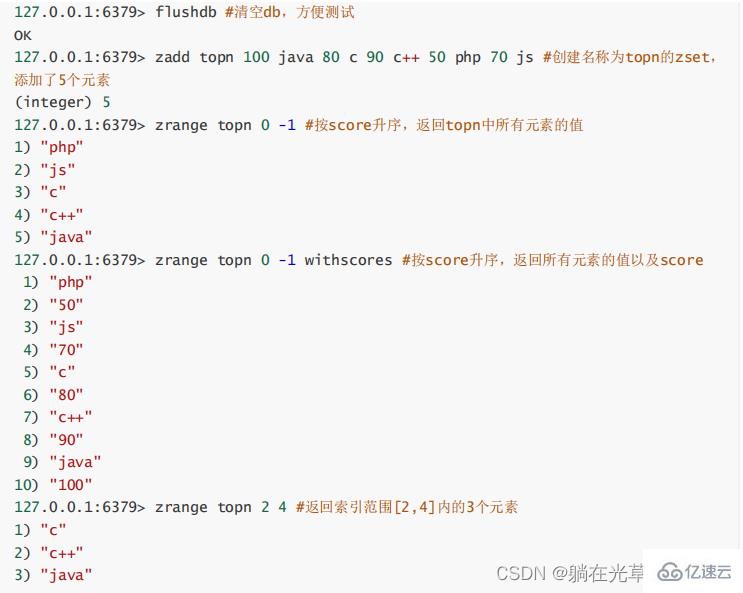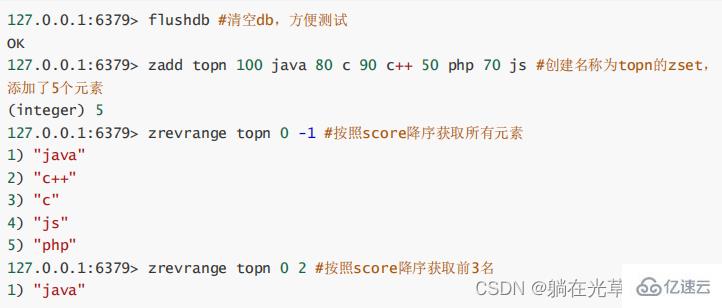What are the knowledge points of Redis ordered set zset?

redis ordered set zset is very similar to an ordinary set, it is a string collection without repeated elements.
The difference is that each member of the ordered set is associated with a score, and this score is used to sort the members of the set from the lowest score
to the highest score.
The members of the collection are unique, but the ratings can be repeated.
Because the elements are ordered, you can quickly get a range of elements
based on score or position.
Accessing intermediate elements in an ordered set is also very fast, because you can use the ordered set as a smart column
table without duplicate members.
zadd: Add elements 
zrange: score ascending order, get the elements of the specified index range
Return stored in the ordered set key elements of the specified range. The returned elements can be thought of as being sorted by score from lowest to highest. If the scores are the same, they will be sorted lexicographically.
The subscript parameters start and stop are both base 0, that is to say, 0 represents the first member of the ordered set, 1 represents
the second member of the ordered set, and so on.
You can also use negative subscripts, with -1 representing the last member, -2 representing the second to last member, and so on.
zrange key 0 -1: All elements can be obtained
withscores: Return the member and its score value together, and the return list is expressed in the format of value1, score1, …, valueN, scoreN
Available versions:
= 1.2.0Time complexity:
O(log(N) M), N is the cardinality of the ordered set, and M is the cardinality of the result set.
Return value:
List of ordered set members with score value (optional) in the specified interval
zrevrange: score descending order, obtain the specified index range Element Returns the specified range of elements stored in the sorted collection key. The returned elements can be considered to be arranged from highest to lowest score
. If the scores are the same, they will be sorted by dictionary.
The subscript parameters start and stop are both base 0, that is to say, 0 represents the first member of the ordered set, 1 represents
the second member of the ordered set, and so on.
You can also use negative subscripts, with -1 representing the last member, -2 representing the second to last member, and so on.
withscores: Return the member and its score value together. The return list is expressed in the format of value1, score1, …, valueN, scoreN
zrangebyscore : Return data within the specified score range in ascending order by score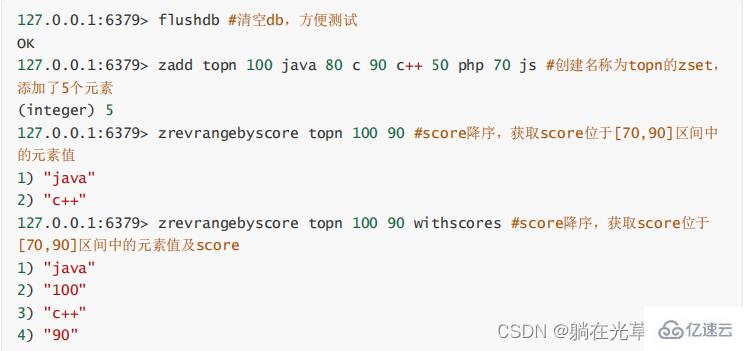
zincrby: Add the specified increment to the score of the specified element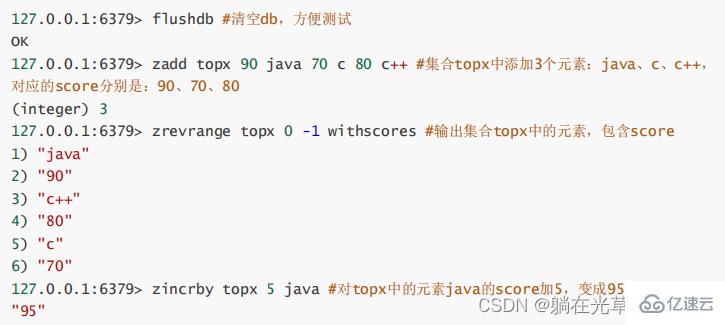 zrem: Delete multiple elements in the collection
zrem: Delete multiple elements in the collection 
zremrangebyrank: Delete elements based on the index range 
zremrangebyscore: Based on Delete elements from the range of score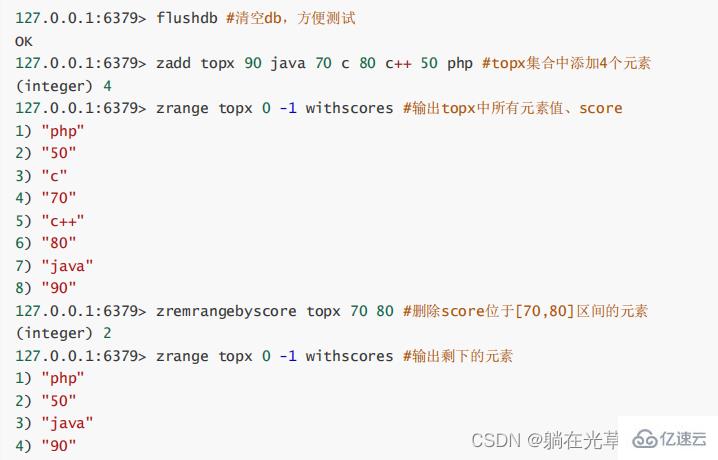
zcount: Count the number of elements within the specified score range
zrank: According to score In ascending order, return the ranking of an element in the set
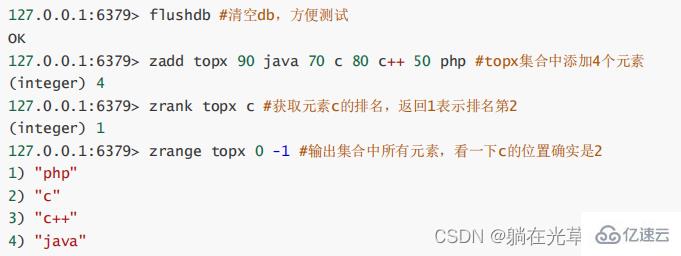
zrevrank: In descending order of score, return the ranking of an element in the set 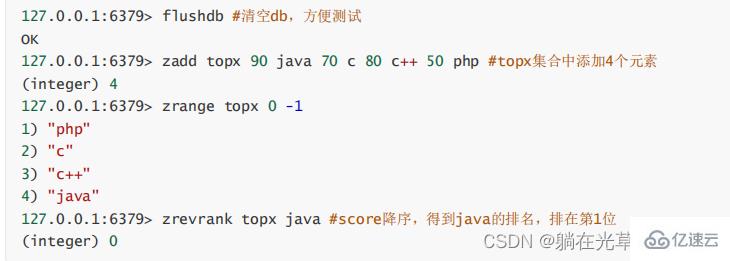
zscore: Returns the score of the specified element in the collection
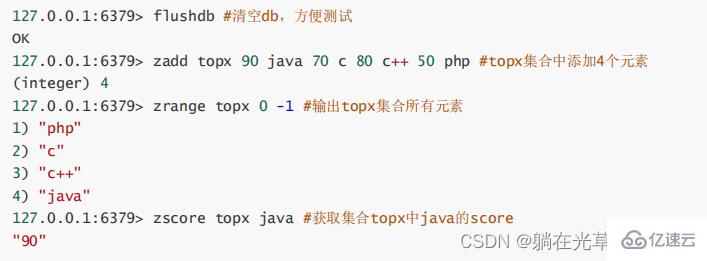
Data structure
SortedSet (zset) is a very special data structure provided by redis. Two data structures are used internally.
1. Hash table
is similar to Map
the element. The time complexity is O(1)
2. Skip list
The skip list is a very excellent data structure with simple implementation. The complexity of insertion, deletion and search is O(logN).
Similar to ConcurrentSkipListSet in java, a skip list is generated after sorting according to the score value. You can quickly query elements in the order of position
or the order of score.
The above is the detailed content of What are the knowledge points of Redis ordered set zset?. For more information, please follow other related articles on the PHP Chinese website!

Hot AI Tools

Undresser.AI Undress
AI-powered app for creating realistic nude photos

AI Clothes Remover
Online AI tool for removing clothes from photos.

Undress AI Tool
Undress images for free

Clothoff.io
AI clothes remover

Video Face Swap
Swap faces in any video effortlessly with our completely free AI face swap tool!

Hot Article

Hot Tools

Notepad++7.3.1
Easy-to-use and free code editor

SublimeText3 Chinese version
Chinese version, very easy to use

Zend Studio 13.0.1
Powerful PHP integrated development environment

Dreamweaver CS6
Visual web development tools

SublimeText3 Mac version
God-level code editing software (SublimeText3)

Hot Topics
 1386
1386
 52
52
 How to build the redis cluster mode
Apr 10, 2025 pm 10:15 PM
How to build the redis cluster mode
Apr 10, 2025 pm 10:15 PM
Redis cluster mode deploys Redis instances to multiple servers through sharding, improving scalability and availability. The construction steps are as follows: Create odd Redis instances with different ports; Create 3 sentinel instances, monitor Redis instances and failover; configure sentinel configuration files, add monitoring Redis instance information and failover settings; configure Redis instance configuration files, enable cluster mode and specify the cluster information file path; create nodes.conf file, containing information of each Redis instance; start the cluster, execute the create command to create a cluster and specify the number of replicas; log in to the cluster to execute the CLUSTER INFO command to verify the cluster status; make
 How to clear redis data
Apr 10, 2025 pm 10:06 PM
How to clear redis data
Apr 10, 2025 pm 10:06 PM
How to clear Redis data: Use the FLUSHALL command to clear all key values. Use the FLUSHDB command to clear the key value of the currently selected database. Use SELECT to switch databases, and then use FLUSHDB to clear multiple databases. Use the DEL command to delete a specific key. Use the redis-cli tool to clear the data.
 How to use the redis command
Apr 10, 2025 pm 08:45 PM
How to use the redis command
Apr 10, 2025 pm 08:45 PM
Using the Redis directive requires the following steps: Open the Redis client. Enter the command (verb key value). Provides the required parameters (varies from instruction to instruction). Press Enter to execute the command. Redis returns a response indicating the result of the operation (usually OK or -ERR).
 How to read redis queue
Apr 10, 2025 pm 10:12 PM
How to read redis queue
Apr 10, 2025 pm 10:12 PM
To read a queue from Redis, you need to get the queue name, read the elements using the LPOP command, and process the empty queue. The specific steps are as follows: Get the queue name: name it with the prefix of "queue:" such as "queue:my-queue". Use the LPOP command: Eject the element from the head of the queue and return its value, such as LPOP queue:my-queue. Processing empty queues: If the queue is empty, LPOP returns nil, and you can check whether the queue exists before reading the element.
 How to use redis lock
Apr 10, 2025 pm 08:39 PM
How to use redis lock
Apr 10, 2025 pm 08:39 PM
Using Redis to lock operations requires obtaining the lock through the SETNX command, and then using the EXPIRE command to set the expiration time. The specific steps are: (1) Use the SETNX command to try to set a key-value pair; (2) Use the EXPIRE command to set the expiration time for the lock; (3) Use the DEL command to delete the lock when the lock is no longer needed.
 How to read the source code of redis
Apr 10, 2025 pm 08:27 PM
How to read the source code of redis
Apr 10, 2025 pm 08:27 PM
The best way to understand Redis source code is to go step by step: get familiar with the basics of Redis. Select a specific module or function as the starting point. Start with the entry point of the module or function and view the code line by line. View the code through the function call chain. Be familiar with the underlying data structures used by Redis. Identify the algorithm used by Redis.
 How to solve data loss with redis
Apr 10, 2025 pm 08:24 PM
How to solve data loss with redis
Apr 10, 2025 pm 08:24 PM
Redis data loss causes include memory failures, power outages, human errors, and hardware failures. The solutions are: 1. Store data to disk with RDB or AOF persistence; 2. Copy to multiple servers for high availability; 3. HA with Redis Sentinel or Redis Cluster; 4. Create snapshots to back up data; 5. Implement best practices such as persistence, replication, snapshots, monitoring, and security measures.
 How to use the redis command line
Apr 10, 2025 pm 10:18 PM
How to use the redis command line
Apr 10, 2025 pm 10:18 PM
Use the Redis command line tool (redis-cli) to manage and operate Redis through the following steps: Connect to the server, specify the address and port. Send commands to the server using the command name and parameters. Use the HELP command to view help information for a specific command. Use the QUIT command to exit the command line tool.




